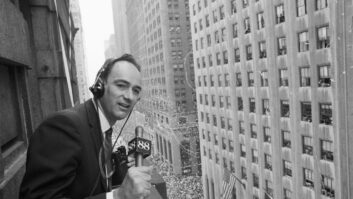WQRZ, Licensed to a Ham Group, Broadcasts During & After Hurricane
BAY ST. LOUIS, Miss. The creation of a low-power FM radio service in 2000 was supposed to enhance radio service, typically in smaller markets. It certainly worked in at least one rural Mississippi county during Hurricane Katrina, according to those familiar with the circumstances.
WQRZ(LP) was the only Hancock County radio station still broadcasting after Katrina decimated much of the western Mississippi coast in late August. However, managing to stay on the air involved multiple studio moves and the help of outside broadcast suppliers and engineers.
The 100-watt station, licensed to the Hancock County Amateur Radio Association Inc., was the only communications link with the outside world for many area residents in the days immediately following Katrina, according to local emergency management officials.
While some other regional signals could be heard in the area, sources said WQRZ was the only one based in the county that was on the air and trying to provide radio service and information specifically for county residents.
Ham radio, civil defense
“This is exactly the reason why we put the station on the air in 2003. The concept was to put on a station with the intent to broadcast emergency information during emergencies,” said Brice Phillips, chair of the Hancock County Amateur Radio Association Inc. board of directors. “This is exactly what radio is supposed to do, serve their communities.
“We are the only amateur radio group to specifically put on a station for this purpose. To have a ham radio operations center and radio station in the same building for civil defense purposes is unique.”
Hancock County, with 17,460 households and more than 39,000 people, according to census figures, is also home to WBSL(AM), a 5 kW daytime station, owned by Hancock Broadcasting Corp. That station was severely damaged by Katrina.
“They are just mush at this point,” Phillips said in October.
This is not the first time the Mississippi Gulf Coast has been devastated by a hurricane; Camille struck the same area, sometimes referred to as this country’s “third coast,” in 1969.
“In fact, our station’s slogan was ‘Broadcasting through rain, shine or another Camille,’ and this was another big one. This area has historically lacked much emergency communications ability. I think we managed to change that this time,” Phillips said.
Phillips built WQRZ’s studio inside his home, which sits approximately three miles off the beach in Bay St. Louis. Once Katrina reached Category 4 status he realized he had to change locations for his own safety and in order to keep the station on the air, he said.
Phillips, who is a ham radio operator, climbed a 130-foot 25-G Rohn tower on his property and removed one bay of his four-bay, circularly polarized antenna. After scooping up as much studio gear as possible, he moved operations to the Hancock County Emergency Operations Center and resumed broadcasting in Bay St. Louis in the Justice Court Building.
“I mounted the one-bay on a 45-foot tower behind the building and used our DC-powered Crown FM100-E transmitter, which I had grabbed from the house. I ran the coax and was on the air,” Phillips said. He used car batteries at one point to keep the transmitter running.
His temporary studio consisted of four 300-disk CD changers, a microphone and laptop computer, he said. However, the Justice Court Building was only suitable for a short time after part of the building’s roof came off and the building flooded when Katrina’s storm surge struck.
Several studio moves
Phillips next moved to a temporary emergency operations center at a vocational-tech center north of Bay St. Louis and later was forced to another facility near Stennis International Airport, further northwest of Bay St. Louis. It was the first of two locations the station would use near the airport, which sits adjacent to a NASA test site. By this time engineering help had arrived, Phillips said.
Gary Minker, president of Radio Works RF Consulting, said he arrived a week after Katrina hit and went to inspect WQRZ’s transmission facilities at Phillips’ house. He found the house “smashed,” but an outbuilding and the tower remained intact.
“The high watermark on a telephone pole on his property was approximately 25 feet. However, we determined that the antenna on the Rohn tower was salvageable. The transmission line had failed, so we re-fed the antenna and mounted a new STL receive antenna,” Minker said.
Meanwhile, Harris Corp. coordinated with the Florida Emergency Operations Center in Tallahassee in an effort to get broadcast equipment to the storm-ravaged area. When it became clear that WQRZ needed equipment to remain on the air and increase its signal strength, Harris shipped emergency studio gear and a 1 kW Quest transmitter within 24 hours of receiving the request, said Hal Kneller, manager of Public Radio Initiatives for Harris.
“Our GCSD (Government Communications Systems Division) had been talking with the Florida EOC, which was using Tallahassee as a staging area,” Kneller said. “We immediately shipped cables, microphones, headphones, mixer and an Optimod from our facility in Mason, Ohio, and the transmitter from Quincy.”
Harris offered turnkey installations to stations affected by Hurricane Katrina, shipping pre-made shelters with transmitters and equipment pre-wired, Kneller said.
Kneller said Harris would eventually have discussions with WQRZ officials regarding its equipment and long-term financing options available if the equipment provided is still needed.
Minker met the Harris shipment, which included a Dielectric one-bay FM antenna, in Tallahassee and loaded up his recreational vehicle.
“You just bring as much test equipment and do whatever you need to keep the station on the air. You assess the situation, assess for safety and get the job done,” Minker said.
Rebuilding the transmitter site at Phillip’s house became the priority for Minker. The utility shed was cleared of bayou mud and sediment to accommodate the Quest transmitter. A diesel generator powered the site, Minker said.
FCC grants power increase
With the WQRZ transmitter site functioning and the temporary studio at Stennis International Airport buoyed by the additional Harris gear, local Hancock County emergency managers requested that Phillips seek a temporary power increase to allow the station’s signal to cover the entire county, Phillips said.
Sara Allen, president of Ciara Enterprises Inc., a broadcast engineering consulting firm, said she responded to a request from the Society of Broadcast Engineers to assist stations hard hit by Katrina.
“I did request special authorization from the FCC to get the power increase,” Allen said. Local emergency managers “needed a tool to communicate emergency rumor control, health and welfare information directly to the people of that county.” She arrived in Bay St. Louis approximately a week after the hurricane.
Allen, who also serves on the Toolkit Work Group for the FCC’s Media Security and Reliability Council and is developing a model disaster recovery-planning document, said she received Special Temporary Authority to raise the station’s power to 4 kW.
“The FCC expedited our request. However, the most we could use was 1,300 watts due to some technical limitations to the antenna, which was designed to handle only about 1 kW. Still, it was enough power to give us a radius of about 17 miles and enough to cover the entire county at 103.5, ” Allen said.
Allen spent several weeks helping Phillips with technical issues and even subbed on the air occasionally during that time.
“I learned that good radio can be produced with minimal equipment and that desperate times call for desperate measures, including finding fuel wherever and whenever possible,” Allen said.
Acquiring fuel to keep the generator running at WQRZ’s transmitter site was a logistical challenge, she said, with Phillips even floating in 10-gallon cans of diesel in chest-deep water during Hurricane Rita, which followed on the heels of Katrina, to keep WQRZ on the air.
Phillips said he expects to move WQRZ’s studios to a building in Kiln, Miss., this fall before eventually rebuilding permanent facilities on his property.
“We may be eligible for a public assistance grant to rebuild. It’s always been a financial struggle and things are even worse now,” Phillips said.
Meanwhile, the STA expires in early December, but Phillips said he expects to apply for an extension.
As for the help Phillips received in the months following Katrina, he said, “We realized we were not in this alone. Hopefully this will inspire other folks in other communities that when you have to deal with man-made or natural disasters it can be done.”












